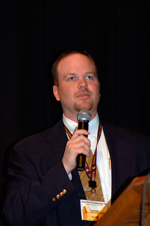Calf Management Affects Quality Grade
Feeding strategy to maximize grain intake during key periods reduces feeding costs while seeking carcass weight and quality.
by Troy Smith for Angus Productions Inc.
CASPER, Wyo. (Dec. 2, 2009) — Beef quality grade is important. That’s a matter of fact, said University of Wyoming Animal Scientist Scott Lake while addressing the 2009 Range Beef Cow Symposium in Casper, Wyo.
 "It is possible to feed high-energy diets to beef cattle during strategic periods of time [to] produce carcasses with quality comparable to those of early-weaning systems, as well as take advantage of lower-input feeding periods," said Scott Lake, University of Wyoming.The National Beef Quality Audit reported a leading concern among beef packers and merchandisers is insufficient marbling to achieve a desirable quality grade, Lake noted. Premiums are paid on the basis of carcass quality. And management and marketing practices have been developed around the Choice-Select spread.
"It is possible to feed high-energy diets to beef cattle during strategic periods of time [to] produce carcasses with quality comparable to those of early-weaning systems, as well as take advantage of lower-input feeding periods," said Scott Lake, University of Wyoming.The National Beef Quality Audit reported a leading concern among beef packers and merchandisers is insufficient marbling to achieve a desirable quality grade, Lake noted. Premiums are paid on the basis of carcass quality. And management and marketing practices have been developed around the Choice-Select spread.
“Developing a means to improve the efficiency of production and profitability of high-quality beef carcasses is essential to increase beef quality and the economic viability of producers,” Lake said. Strategic management of nutrition for early-weaned calves could be a viable alternative to traditional ways of feeding cattle, he added.
Extensive research during the last decade suggests that early weaning of calves (at 100 to 150 days of age) is a viable option to improve carcass quality, Lake said. It is now known that marbling development begins early in a calf’s life and can be enhanced by weaning calves early and placing them on diets containing higher levels of energy (grain). However, early weaning generally means more total days on feed, higher total feed costs and the calves usually produce lighter carcasses.
While premiums are paid for higher quality, carcass weight remains the major economic driver of carcass value, accounting for approximately 70% of total revenue from finished animals, Lake said. With the recent dramatic increase in feed costs came incentives to manage calves for slower growth rates and decreased inputs. Cattle feeders want to minimize the length of time cattle are in the feedlot and many have returned to sourcing yearlings for placement rather than calves.
“Given our understanding of muscle growth and fat accretion, it is possible to feed high-energy diets to beef cattle during strategic periods of time [to] produce carcasses with quality comparable to those of early-weaning systems, as well as take advantage of lower-input feeding periods, allowing for similar skeletal growth seen in yearling cattle, thus producing heavier carcasses,” Lake said.
Preliminary data suggest early-weaned calves can be fed a high-concentrate diet for about 100 days, followed by a period when calves are treated more like a yearling. After this period of time on a slow plane of nutrition, they are returned to the feedlot and a high-concentrate finishing diet. The desired results are carcasses of higher quality grade and weights similar to those of traditionally fed cattle.
“The objective is to maximize grain intake strategically, during key periods of time, to keep total feeding costs lower and still achieve heavier carcasses of high quality.”
Editor’s Note: API's coverage of the event is made available for distribution to all media via an agreement with the Range Beef Cow Symposium Committee and API. Headquartered in Saint Joseph, Mo., API publishes the Angus Journal, the Angus Beef Bulletin, the Angus Beef Bulletin EXTRA, and the Angus e-List, as well as providing online coverage of events and topics pertinent to cattlemen through the API Virtual Library. For questions about this site, or to notifiy us of broken links, click here.
